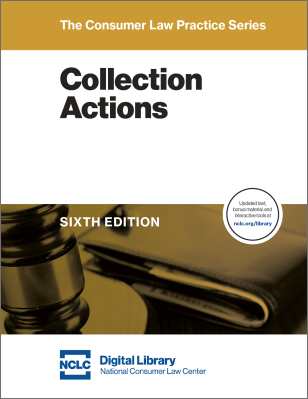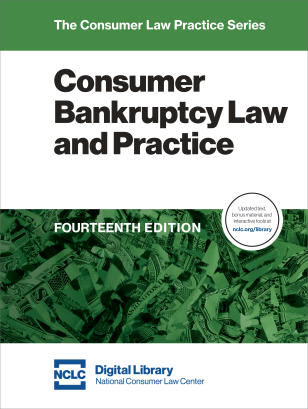Need for Special Relief from Criminal Justice Debt
A recent study found over $25 billion in fines and fees presently outstanding in the United States, imposed as a result of interactions with the criminal justice system. The full amount is dramatically higher, as only half the states provided data. Courts impose fines as monetary infractions for violating criminal, traffic, and municipal laws. Numerous hefty fees are typically tacked onto the fines to fund specific legal system costs or to fund government operations more generally. Fees tend to operate as a regressive tax.
Unlike credit card or other unsecured debt, these unpaid obligations can result in draconian consequences—including the threat of actual incarceration for nonpayment, suspension of drivers’ licenses, and denial of the right to vote. The over-policing of communities of color and the racial wealth gap mean that these harsh consequences fall disproportionately on persons of color. See generally NCLC’s Clearing the Path to a New Beginning: A Guide to Discharging Criminal Justice Debt in Bankruptcy (Oct. 2020) and NCLC’s Criminal Justice Debt in the South (Dec. 2018).
For a detailed discussion of the various types of criminal justice debt, and consumer tactics to reduce the debt or avoid the worst consequences of nonpayment, see NCLC’s Collection Actions Chapter 11. The chapter considers defenses based on federal and state constitutional protections, inability to pay, right to counsel in the criminal case, statute of limitations, and exemptions, as well as approaches to reduce or eliminate the debt and affirmative litigation against criminal justice debt abuses. This article instead focuses only on how practitioners can use bankruptcy to discharge certain types of criminal justice debt.
Bankruptcy Can Eliminate Some Types of Criminal Justice Debt
At first glance, bankruptcy is not a promising approach to dealing with criminal justice debt: criminal fines imposed in sentencing orders and victim restitution may not be dischargeable in bankruptcy. Exempted from discharge in a chapter 7 bankruptcy case is a “fine, penalty, or forfeiture payable to and for the benefit of a governmental unit [that] is not compensation for actual pecuniary loss.” Bankruptcy Code, 11 U.S.C. § 523(a)(7). An exception to discharge for chapter 13 cases covers debts for “restitution, or a criminal fine, included in a sentence on the debtor’s conviction of a crime.” Bankruptcy Code, 11 U.S.C. § 1328(a)(3).
Reform of the Bankruptcy Code is essential to ensuring that bankruptcy affords a true fresh start for those with criminal justice debt and to avoiding some of the debt’s most draconian consequences. For example, fines imposed outside of adult criminal convictions could be made dischargeable, and those imposed as part of a criminal conviction could become dischargeable following a waiting period. Another possibility, which could be implemented alongside this, is to explicitly provide that all fees, charges, and surcharges imposed as part of a criminal proceeding be dischargeable in bankruptcy.
But even with this need for reform concerning the dischargeability of fines and restitution, certain criminal justice debt may be dischargeable in a bankruptcy. The example below will provide a good introduction to how bankruptcy can reduce certain criminal justice debts, with far more detail found in four important NCLC resources:
- May 13, 2:00 p.m. EST Webinar: Using Bankruptcy Law to Provide Relief from Criminal Legal System Debt, examining the burden of criminal justice system debt on individuals and communities, guiding participants through the benefits and limitations that the Bankruptcy Code presents, and recommending reforms to the Bankruptcy Code to ensure that people with criminal justice debt can get meaningful relief through bankruptcy. This Webinar is FREE. Presented by Amreeta Mathai, American Civil Liberties Union; Geoff Walsh, NCLC; and Andrea Bopp Stark, NCLC. Register here. NCLC webinar recordings are also available at NCLC’s website.
- NCLC’s Clearing the Path to a New Beginning: A Guide to Discharging Criminal Justice Debt in Bankruptcy (Oct. 2020) (50 pp.)
- NCLC’s Consumer Bankruptcy Law and Practice § 15.4 (the discussion of non-dischargeable debts found in the definitive two-volume guide to consumer bankruptcy practice).
- NCLC’s Collection Actions § 11.5 (using bankruptcy to deal with criminal justice debt).
An Illustrative Example of Bankruptcy’s Ability to Reduce Criminal Justice Debt
Here is an example showing where bankruptcy might be successfully used to eliminate an individual’s criminal justice debt—in this case, possibly 78% may be dischargeable. While few cases present this proportion of criminal justice debt that may be dischargeable, the example is useful as an illustration.
Mr. Smith believes that the collection activity stems from a fine he was ordered to pay several years ago after he pleaded guilty to a charge of retail theft from a department store. He remembers that the judge in the criminal court ordered him to pay a $2,500 fine and $250 in restitution to the store for the value of the merchandise. The most recent letter from Apex claims that Mr. Smith owes $12,634.
You track down the sentencing order from Mr. Smith’s criminal case. The order clearly imposes the fine and restitution, as described by Mr. Smith, but also lists a $750 assessment for “indigent defense” and a $425 charge for “costs of pre-trial detention.” The order also sentenced Mr. Smith to six months incarceration.
Further conversations with Mr. Smith and more review of court records bring additional facts to light. Mr. Smith qualified for public defender representation in the criminal proceeding and Mr. Smith was held in pre-trial detention for approximately three weeks prior to his guilty plea, in part because he lacked the financial resources to access a bond or to pay bail. After he pleaded guilty, Mr. Smith served four months of incarceration and then was released for a one-year period of supervised parole. He complied with all terms of his parole.
Over the past two years Mr. Smith received numerous written and telephonic communications from Apex demanding the following:
| Fines and penalties | $ 2,500 |
| Restitution | $ 250 |
| Indigent defense charges | $ 750 |
| Costs of pre-trial detention | $ 425 |
| Costs of post-sentencing detention | $ 4,270 (122 days at $35.00/day) |
| Parole supervision fees | $ 675 |
| Surcharge | $ 519 |
| Collection costs | $ 2,527 (assessed at 25% of total debt owed) |
| Interest | $ 540 |
| Court filing fees | $ 178 |
| TOTAL | $12,634 |
Turning a $12,634 Debt Into $2,750
Based on these facts, and current court interpretations of Bankruptcy Code § 523(a)(7), this is how a chapter 7 bankruptcy might be able to deal with each of the components of the $12,634 criminal justice debt:
1. The $2,500 fine for retail theft, a court-ordered criminal fine imposed in a sentencing order, is non-dischargeable in bankruptcy.
2. The $250 restitution order for the benefit of a private party and as compensation for that party’s loss appears to be dischargeable based upon a plain text reading of § 523(a)(7). However, under the Supreme Court standard enunciated in Kelly v. Robinson, 479 U.S. 36, 50 (1986) this debt is non-dischargeable because it is a condition a state criminal court imposed as part of a criminal sentence.
3. The $4,270 assessment for the cost of post-sentencing detention a purely compensatory charge assessed by state officials after Mr. Smith’s sentencing and not included in the criminal court’s sentencing order. Here is an example showing where bankruptcy might be successfully used to eliminate an individual’s criminal justice debt—in this case, possibly 78% may be dischargeable. While few cases present this proportion of criminal justice debt that may be dischargeable, the example is useful as an illustration not be subject to the § 523(a)(7) discharge exception, so should be discharged in bankruptcy.
4. The $675 fees for parole supervision are also purely compensatory charges assessed by state officials after Mr. Smith’s sentencing and not included in the sentencing order. It should be dischargeable.
5. The $2,527 collection fee, the $540 interest charge, and the $178 court filing fee do not fall within the § 523(a)(7) discharge exception because: (1) they were not payable to a governmental unit; (2) even if paid to a governmental unit, they were purely compensatory charges for specific costs incurred by the governmental unit; (3) at least a portion of these collection charges were incurred in attempts to collect dischargeable debts. As a result, these charges should be dischargeable in bankruptcy.
6. The $519 “surcharge” is likely dischargeable, and the creditor bears the burden of establishing that its fits within the definition of a nondischargeable debt under 11 U.S.C. § 523. It is not clear from this vague description what the charge is for. After a bankruptcy discharge, the debt collector proceeds at its risk to collect on this debt. See NCLC’s Consumer Bankruptcy Law and Practice § 15.5.5.7.
7. The $750 indigent defense charge incurred when Mr. Smith lacked financial resources to pay for a private attorney, was assessed as a direct consequence of Mr. Smith’s indigence. The charge can be challenged on constitutional grounds. NCLC’s Collection Actions § 11.2.
8. The $425 costs of pre-trial detention were assessed against Mr. Smith as a direct consequence of his indigence. He could not afford access to bail or bond options and therefore was forced to submit to a pre-trial detention that accused defendants with financial resources could avoid. These costs can be challenged on constitutional grounds as well.
For more detail on the above, see NCLC's Clearing the Path to a New Beginning: A Guide to Discharging Criminal Justice Debt in Bankruptcy, at 9; NCLC’s Collection Actions § 11.5. Also tune in to the May 13 webinar or view its recording at NCLC’s website.
The Chapter 7 Bankruptcy Option
The above example describes how all but $2,750 of the $12,634 in criminal justice debt might be dischargeable in a chapter 7 case. Chapter 7 would make sense as long as Mr. Smith does not own any non-exempt assets and meets the other basic chapter 7 eligibility requirements. For example, there are limits on repeat filings and consumers must take a brief credit counseling course before they file. There are also costs to filing bankruptcy—filing fees (payable in installments) and any payments to the attorney handling Mr. Smith’s bankruptcy.
If Mr. Smith has paid $1,000 so far through the garnishment and this payment is appropriately applied to the non-dischargeable portion of the debt, Mr. Smith could emerge from bankruptcy owing only $1,250 as a non-dischargeable criminal justice debt. He may also benefit from the discharge of other obligations that limit his ability to pay the non-dischargeable debt.
The Chapter 13 Option
Chapter 13 allows debtors to repay all or a portion of what is owed on pre-bankruptcy debts under the terms of a plan that lasts from three to five years. Amounts still owed on the debts at the end of the plan are discharged. However, exceptions to discharge of fines and restitution apply in chapter 13 as well as in chapter 7.
Chapter 13 has advantages over chapter 7 when it comes to discharging certain civil penalties. However, in Mr. Smith’s case the $2,500 criminal fine and the $250 restitution order that are non-dischargeable in chapter 7 are also non-dischargeable in chapter 13. Chapter 13 involves a significant commitment of time and expenses, so for the limited purpose of addressing his criminal justice debt, chapter 7 likely best meets Mr. Smith’s needs.
Nevertheless, in some instances, consumers may be able to use chapter 13 to extend payment times on a non-dischargeable debt, thereby reducing the monthly payment amount that would apply outside of bankruptcy. In re Coulter, 305 B.R. 748 (Bankr. D.S.C. 2003). Consumers may also be able to treat a non-dischargeable criminal justice debt as a preferred debt under a plan and pay it off ahead of other debts. The consumer can control payment terms more favorably with this type of plan, but not all bankruptcy courts allow for preferential treatment of one type of debt in a plan. For more detail on chapter 13 bankruptcies, see NCLC’s Clearing the Path to a New Beginning: A Guide to Discharging Criminal Justice Debt in Bankruptcy, at 22; NCLC’s Consumer Bankruptcy Law and Practice Chapter 12.
Determining the Dischargeability of a Particular Form of Criminal Justice Debt
The dischargeability of a particular type of criminal justice debt may not be determined in the bankruptcy proceeding. The collector, after the discharge, collects on that debt at its own peril. Permanent bankruptcy protection comes into effect with the bankruptcy court’s entry of a discharge order. This occurs after the chapter 7 case has been administered, typically three to five months after the petition filing. 11 U.S.C. § 524(a). The court enters the chapter 13 discharge after the debtor has completed payments under a plan. 11 U.S.C. § 1328(a). The discharge order is a federal court injunction that prohibits creditors from collecting on a debt covered by the discharge.
The discharge order is not self-enforcing. Therefore, disputes as to whether a particular criminal justice debt is covered by the discharge order typically arise when the creditor persists in enforcing a debt despite knowledge that the debtor obtained the bankruptcy discharge. An adversary proceeding (a federal court complaint) filed in the bankruptcy case can seek a declaration that a particular debt or set of debts was discharged as well as seeking contempt sanctions for violation of the discharge order in appropriate cases. See NCLC’s Consumer Bankruptcy Law and Practice § 15.5.5.7.
The Bankruptcy Automatic Stay’s Impact on Collection of Criminal Justice Debt
A major benefit of bankruptcy is that the filing of a case triggers an automatic stay of actions to collect on pre-bankruptcy debts. 11 U.S.C § 362(a). However, an exception to the automatic stay applies to “the commencement or continuation of a criminal action or proceeding against the debtor.” 11 U.S.C. § 362(b)(1). Collection of criminal justice fees and charges sometimes fall into a gray area under this standard. See NCLC’s Clearing the Path to a New Beginning: A Guide to Discharging Criminal Justice Debt in Bankruptcy, at 34; NCLC’s Collection Actions § 11.5.2; NCLC’s Consumer Bankruptcy Law and Practice § 9.4.6.2
If the collection activity involves the enforcement of a specific court order directing fixed payments under a defined schedule, the continuing collection activity is likely excepted from the automatic stay and can proceed despite the bankruptcy. Actions by a private debt collector to collect on debts assessed outside of the sentencing order are more likely to be barred by the stay.




